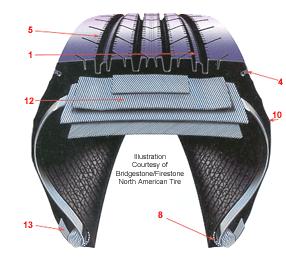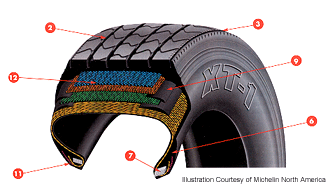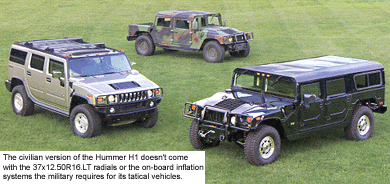Is a tire just a tire? Well, yes and no. In the medium truck tire world, the products you will sell and service are functionally the same – they are made of a mix of rubber and other compounds, usually contain steel belts, have sidewalls and beads, and have a tread with grooves or lugs.
When you consider all the different brands and manufacturers in the market, those simple functional similarities end. Selling medium truck tires is hard enough, but if you carry multiple brands, you have to deal with different nomenclature. One company’s “stone ejector” feature is another’s “rejector platform.” Keeping everything straight – and understanding what these features provide – can be maddening.
We’ve poured through dozens of databooks and other tiremaker literature and compiled a rundown of the industry’s vast array of truck tire features. To the best of our ability, we have tried to include nomenclature from every tire marketer, and we have focused on the primary components and features of a modern radial truck tire. Items listed are alphabetized.
Call it Truck Tires 101, this story could serve as a good primer for your future in the tire industry. Some of the items are highlighted on the accompanying illustrations.
Tread Area Features
Cap/Base Tread Compound – The tread base, also known as “undertread,” is a special rubber compound under the tread compound that helps dissipate heat build up and improve durability. The tread cap is the actual tread compound.
Closed Shoulder Lug Pattern – Also called “continuous shoulder ribs,” this is a tread pattern featuring shoulder ribs surrounding deep tread lugs. Common for drive axle applications, shoulder ribs help fight tread lug irregular wear common on open shoulder lug patterns.
-
- Equalizer Rib – Found in a tread groove between ribs, it helps equalize pressure on the shoulder ribs to help inhibit irregular wear.
Open Shoulder Lug Pattern – Tread pattern featuring open lugs across the entire tread face, shoulder to shoulder, for added traction. Designed primarily for off-road use and extremely soft surfaces. Sustained on-road use could cause irregular wear on tread lugs. Rib Tread Pattern – A tread pattern with multiple circumferential ribs with wide tread grooves, commonly used on steer and trailer axle positions. These can also be used on drive tires on trucks that never encounter snow or travel off road.
- Equalizer Rib – Found in a tread groove between ribs, it helps equalize pressure on the shoulder ribs to help inhibit irregular wear.

-
- See Through Grooves – Also called “flow through grooves,” these are open continuous circumferential grooves designed to resist hydroplaning.
Shoulder Buttress – Also called “buttress shoulders,” these are common on open lug tread patterns or semi-continuous shoulder ribs, and refers to the area where the base of the outside lugs are built up. This buttress is designed to add tread area and shoulder durability.
- Shoulder Groove – Called a “defense groove” or “decoupling groove” or “shoulder wear protector” or “pressure distribution groove” by some tiremakers, it is a thin circumferential groove near the apex of a tire’s shoulder. This groove creates a narrow rib along the shoulder. The concept is that it will wear faster than the adjacent shoulder rib, thereby minimizing shoulder edge wear.
- Side Groove – Located high on a tire’s shoulder, near the tread face, this rounded groove helps minimize irregular shoulder wear by opening and closing as forces on the tire shoulder change.
- Sipes – Serve two primary purposes in medium truck tires: 1) provide added biting edges for traction, and 2) relieve stress on tread elements to fight irregular wear. Siping on rib edges specifically fight “river” or “wavy” wear.
Stone Ejectors – Also called “rejector platforms,” these small platforms between tread grooves are designed to prevent stones or other cutting objects from becoming lodged between ribs. Once such an object becomes stuck in a groove, the sawing motion of the object caused by a tire’s constant flexing can create severe casing damage. Tie Bars – Small segment of rubber that links tread elements together to help fight irregular wear-causing tread element squirm. Tie bars are usually found on more premium rib tires.
- See Through Grooves – Also called “flow through grooves,” these are open continuous circumferential grooves designed to resist hydroplaning.
Casing Construction Features
-
- Apex – Rubber pieces at the bead and lower sidewall area that help stiffen the bead area and provide a transition to the more flexible sidewall area.

- Bead – Made of wound high-tensile steel. Round, square or semi-rectangular in shape, the bead keeps the tire on a wheel, and adds to sidewall stiffness.
- Bead Chafer – Made of either hard rubber or steel wire, it protects the bead area from rim abrasion and flex damage, and protects bead components.
- Belt Edge Inserts – Also called “belt wedge inserts,” these are rubber strips between the second and third steel belts that help reduce stress at the edge of the belts.
Bead Filler – Provides lateral stability by stiffening the lower sidewall, and maximizes traction, steering response, high-speed stability and casing durability.
Guide Ribs – “Lines” around the sidewall, usually located within an inch or two of the bead, that are used as a reference to determine proper seating of the bead on a wheel.
Innerliner – A layer or layers of special rubber compounds inside a tubeless tire that resists air and moisture permeation.
- Sidewall Protector Ribs – Also called “curbing rib” or “curb guards” or “scuff bars,” these are common on high scrub applications where curbing is possible because of tight maneuvering and cornering (city streets, P&D trucks, loading docks, rail yards). While such ribs won’t eliminate damage, protector ribs can minimize the effects of scrapes, cuts, abrasions and scuffs.
- Stabilizer Ply – Rubber-based ply laid over the ply turnup and under the chafer that reinforces and stabilizes the transition area between the bead and the sidewall.
- Steel Belts – In most steel radial truck tires, there are full-width and partial-width belts. The bottom belt, closest to the carcass plies, is called the “transition belt,” and is made up of either two partial-width or one full-width steel belt. The second and third belts are full-width and are called the “stabilizer belts.” The fourth, normally slightly less than full-width, is commonly referred to as the “protector belt” or “protector ply.”
- Turn Up Ply – Also called “high ply turn up” or “ply turnup,” this construction feature is located where the main casing plies wrap under the bead and back up the sidewall. This serves to stiffen the sidewall for stability and responsiveness.
Rubber Compounds and Terms
Natural rubber is ideal because of its inherent durability, flexibility, and heat dissipation properties. But to control its performance, you need to add synthetic rubber and other materials. Synthetic rubber can be engineered to deliver a wide range of properties – long wear, low rolling resistance, heat resistance, wet and dry traction, and cut and abrasion resistance, for example. The different rubber elements in a tire each have different ratios of natural to synthetic rubber in their compound mix. And, obviously, different tiremakers use different rubber blends in their products. Other materials common in rubber compounds include:
Accelerators – Overcuring or undercuring rubber can cause unintended damage to a tire. Basically, accelerators are various chemicals that help make sure the variety of different rubber compounds in a tire finish curing at the same time.
Antioxidants and Antiozonants – Chemicals mixed into rubber compounds to fight rubber degradation due to exposure to oxygen and ozone.
Carbon Black – An oil-based product, carbon black is an ultra-fine powder of pure carbon and comprises some 30% of a tire’s mass. It is primarily a filler in rubber compounds, adding reinforcing properties that help make a rubber compound resistant to wear and abrasions. It is also why tires are black.
Sulfur – A vital vulcanizing agent, sulfur links rubber molecules together, giving rubber strength and resistance to heat and cold.
Wax – Also used to help control the rate at which a rubber compound cures, wax also helps prevent oxidation. Zinc Stearate – Commonly used to help control rubber cure rate and make rubber easier to process.
Military Truck Tires
With military equipment playing such a prominent role in world news recently, it might be interesting to review the types of tires on military trucks and compare them to our more familiar over-the-road highway tires.
 First, both tire types perform the same basic functions of supporting loads, transferring driving and braking torques, generating cornering forces, and cushioning impacts from the variety of surfaces being traversed. Military tires, however, tend to be vehicle-specific designs that incorporate mobility and damage resistance features that go beyond on/off road truck tires. Tactical vehicles comprise the largest segment of off-road military trucks, and are generally divided into three categories: Light, Medium and Heavy.
First, both tire types perform the same basic functions of supporting loads, transferring driving and braking torques, generating cornering forces, and cushioning impacts from the variety of surfaces being traversed. Military tires, however, tend to be vehicle-specific designs that incorporate mobility and damage resistance features that go beyond on/off road truck tires. Tactical vehicles comprise the largest segment of off-road military trucks, and are generally divided into three categories: Light, Medium and Heavy.
The Ever Popular Humvee
Typical of Light category vehicles is the High Mobility Multipurpose Wheeled Vehicle (HMMWV), or “Humvee.” It’s the military parent of the civilian Hummer H1. The military version is fitted with aggressive tread 37×12.50R16.5LT radial tires, and Humvees can include on-board inflation systems, allowing tire pressures to be tailored to different terrain on the fly, adding greatly to its flexibility.
In earlier days of bias ply tires (military vehicles were among the last to convert to radial, primarily because of the long vehicle life span and durable bias ply sidewalls), different tires, tailored to the theater of operation, were sometimes fitted. For example, sand tires, with wide, smooth treads having several straight circumferential grooves, were used for desert terrain.
This was necessary because a bias footprint area didn’t vary much with inflation pressure differences. Also, casing durability was often compromised when the tires were run for long distances, or at higher speeds, with low pressures.
Modern radials, on the other hand, can be designed to be very durable under much wider ranges of inflation pressures and footprint lengths. Low inflations, and corresponding longer footprints, allow radial sand tires to perform well in sand or as flotation tires when at low pressures. They can also be very durable at high speeds in over-the-road use when inflated to higher pressures.
Bead locks are also fitted to keep the tire bead and lower sidewall areas firmly seated on the wheel. This aids vehicle stability and mobility in the event of complete air loss.
For Big Machines
Medium tactical vehicles, such as the traditional 4×4 and 6×6 all-wheel drive transports, are typically equipped with 11.00R20, 14.00R20, or 395/85R20 tires. A majority of these are tubeless designs, even though they are fitted to flat base wheels.
This is accomplished by using two-piece wheel designs, which include sealing O-rings similar to the mounting systems used on large earthmovers. Some of these applications include supplemental run-flat devices to allow continuing mobility.
Heavy tactical vehicles include a wide array of larger trucks, tractors and specialty trailers tailored to transport specific equipment, troops and weapons systems. Popular chassis configurations are 8×8 and 10×10 (twin steer axle) all-wheel drive units with tires mounted as singles.
The most popular tire sizes for Heavy trucks is 16.00R20, most of which are tubeless designs to enhance durability, minimize downtime, and reduce required maintenance.
Code Word: Mobile
Mobility is the word that best describes the design emphasis of tires for military vehicles. Large diameter tires are preferred for the added ground clearance afforded and the lower spring rates that help to cushion ride when operating over rough terrain. Also, wear and tear on suspension parts and other vehicle components is reduced with these higher profile tires.
Larger rolling diameters also lay down a longer footprint for better traction and flotation in soft soil or sand conditions. Tire size and load range selection usually differ for military applications since the tires must be capable of operating at low inflation pressures while maintaining a full load.
Sidewall designs are also different for many military tire applications. First, long-term weathering resistance is required to assure the tires remain ready for duty.
Secondly, extra sidewall abrasion resistance requires heavier, thicker rubber reinforcement for use on rock, debris or other adverse surfaces. Understandably, this feature was a primary reason that bias tires remained popular in military applications for so long.
Newer technology and materials are now used for military radials that greatly upgrade durability and overall performance, and allow the lower spring rate (softer ride) and improved fuel efficiency provided by radials.
Tire ‘Service’
Most routine tire service required for military vehicles is performed by military personnel trained in maintenance procedures for the specific type equipment under their responsibility. There may still be instances, however, when civilian servicing tire dealers become involved.
Tube-type tires and multi-piece wheels are still common, however the military is converting to tubeless radials with two-piece wheels to reduce component parts and allow for run-flat capability. Special tires, wheels and run-flat devices may be required if replacement is needed.
Integral run-flat devices may be fitted, and these assemblies require procedures and tools different from typical highway trucks. Servicing personnel must be specially certified to change the two-piece tubeless rims and run-flat devices.
Some of these same cautions should be exercised when servicing ex-military vehicles that have entered civilian service as either work or collector vehicles. Tire and wheel makers, industry associations, and the military maintenance personnel are all good information sources should you run into these kinds of vehicles. Modern line haul radials routinely deliver treadwear, casing durability and fuel efficiency so reliably that operators take them for granted. This is due, in part, to intense competition among major tiremakers, whose products are compared everyday in the commercial marketplace.
Military vehicles, on the other hand, may sit unused for long periods but are expected to perform to high standards on short notice.
Judging by recent events, mission accomplished.


